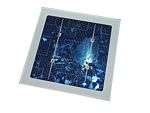Solar backpack

A typical solar backpack
A Solar backpack is a cloth sack carried on one's back and secured with two straps that go over the shoulders, equipped with thin film solar cells and batteries. The solar panels convert sunlight into electricity, which is stored in the batteries and can be used to power portable electronic appliances[1] like mobile phones[2] and mp3 players.[3][4][5]
Features
The solar backpack usually contains a flexible monocrystalline solar panel, battery, charge controller, plugs, cords and light bulbs. It provides users with power up to 120 watt-hours/day, capable of powering electronic equipment rated up to 300 W. It can also be utilized in international aid, disaster relief, emergency power and field research.[6]
Applications

Solar backpack
- A solar backpack system known as Rucksack Enhanced Portable Power System (REPPS), developed by the United States Army Communications-Electronics Research, Development and Engineering Center, features a 62-watt solar panel blanket in a backpack for use by the US army based in Afghanistan. The US Air Force had previously employed solar panels on shipping containers, developed by Lockheed Martin, while the Marines developed suitcase units of foldable solar panels which can also be carried as a backpack. As military equipment like radios and GPS units require lots of energy, these portable solar power systems were designed to minimize dependence of troops on fossil fuels in combat zones. The REPPS is currently utilized by the 173rd Airborne Brigade Combat Team in Logar, Afghanistan. It is used to power electronic devices with a charging time of just 6 hours. As it weighs at around 10 pounds, it can be carried as a backpack easily. In addition to solar power, it can also convert ac power from wall outlets and utilize power from disposable batteries and vehicles.[7]
- Solar backpacks can also power laptops for up to 3 hours.[8]
- After an exposure of about six hours, it can power an emergency light for 14 hours.[6]
- Solar backpacks can also be used to power medical equipment[9] and humanitarian relief efforts[10] where power from the utility grid is not available.
- These types of backpacks can also be used to power cameras for use in remote areas.[11]
Advantages
- Solar backpacks are light-weight, hence making it easier to carry.
- Solar backpacks carry a green energy source for the environment.
- Solar backpacks have a wide range of ideas and opportunities to the society itself.
- (Modern phones use about 1-2 amps of energy. According to research, calculations expected as 10-20% of our electric bills) This can decrease the usage of our energy bills.
- Flexible solar panels also are light and portable, as well as waterproof.[12]
See also
- List of solar powered products
- Solar powered calculator
- Solar notebook
- Solar cell phone charger
- Solar powered watch
- Solar powered refrigerator
References
- ↑ "Grid-Connected Solar Electronics" (PDF). eecs.berkeley.edu. Retrieved 2011-07-25.
- ↑ "The Solar Charging Backpac" (PDF). asr.menloschool.org. Retrieved 2011-07-25.
- ↑ "Futuristic Technology-Solar Backpack" (PDF). met.edu. Retrieved 2011-07-25.
- ↑ "DIY Solar Backpack". npr.org. Retrieved 2011-07-25.
- ↑ "Sun Inspired: How To Build A Solar Backpack". npr.org. Retrieved 2011-07-25.
- 1 2 "Personal Solar Panel Can Power Laptops". panelsolar.org. Retrieved 2011-07-25.
- ↑ "U.S. Army to Use Solar Backpacks In Afghanistan". inhabitat.com. Retrieved 2011-07-25.
- ↑ "Solar backpack". marymount.edu. Retrieved 2011-07-25.
- ↑ "Solar Backpack Shunzaburo Kida" (PDF). ele.uri.edu. Retrieved 2011-07-25.
- ↑ "Photovoltaic systems" (PDF). physics.ohio-state.edu. Retrieved 2011-07-25.
- ↑ "Perspectives in Business" (PDF). think.stedwards.edu. Retrieved 2011-07-25.
- ↑ "Solar Power Advantages and Disadvantages – Part 2". solar-energy-connection.com. Retrieved 2011-07-25.
External links
This article is issued from Wikipedia - version of the 11/11/2016. The text is available under the Creative Commons Attribution/Share Alike but additional terms may apply for the media files.
